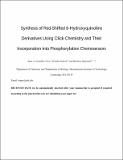| dc.contributor.author | Gonzalez-Vera, Juan A. | |
| dc.contributor.author | Lukovic, Elvedin | |
| dc.contributor.author | Imperiali, Barbara | |
| dc.date.accessioned | 2012-03-08T17:24:17Z | |
| dc.date.available | 2012-03-08T17:24:17Z | |
| dc.date.issued | 2009-09 | |
| dc.date.submitted | 2009-06 | |
| dc.identifier.issn | 0022-3263 | |
| dc.identifier.issn | 1520-6904 | |
| dc.identifier.uri | http://hdl.handle.net/1721.1/69597 | |
| dc.description.abstract | Protein phosphorylation is a ubiquitous post-translational modification, and protein kinases, the enzymes that catalyze the phosphoryl transfer, are involved in nearly every aspect of normal, as well as aberrant, cell function. Here we describe the synthesis of novel, red-shifted 8-hydroxyquinoline-based fluorophores and their incorporation into peptidyl kinase activity reporters. Replacement of the sulfonamide group of the sulfonamido-oxine (1, Sox) chromophore, which has been previously used in kinase sensing, by a 1,4-substituted triazole moiety prepared via click chemistry resulted in a significant bathochromic shift in the fluorescence excitation (15 nm) and emission (40 nm) maxima for the Mg2+ chelate. Furthermore, when a click derivative was incorporated into a chemosensor for MK2, the kinase accepted the new substrate as efficiently as the previously reported Sox-based sensor. Taken together, these results extend the utility range of kinase sensors that are based on chelation-enhanced fluorescence (CHEF). | en_US |
| dc.description.sponsorship | National Institutes of Health (U.S.) (NIH Cell Migration Consortium (GM064346)) | en_US |
| dc.description.sponsorship | A.M. Escudero Foundation | en_US |
| dc.description.sponsorship | Massachusetts Institute of Technology (Department of Chemistry Instrumentation Facility (NIH-1S10RR013886-01)) | en_US |
| dc.language.iso | en_US | |
| dc.publisher | American Chemical Society | en_US |
| dc.relation.isversionof | http://dx.doi.org/10.1021/jo901369k | en_US |
| dc.rights | Article is made available in accordance with the publisher's policy and may be subject to US copyright law. Please refer to the publisher's site for terms of use. | en_US |
| dc.source | Prof. Imperiali via Erja Kajosalo | en_US |
| dc.title | Synthesis of Red-Shifted 8-Hydroxyquinoline Derivatives Using Click Chemistry and Their Incorporation into Phosphorylation Chemosensors | en_US |
| dc.type | Article | en_US |
| dc.identifier.citation | González-Vera, Juan A., Elvedin Luković, and Barbara Imperiali. “Synthesis of Red-Shifted 8-Hydroxyquinoline Derivatives Using Click Chemistry and Their Incorporation into Phosphorylation Chemosensors.” The Journal of Organic Chemistry 74.19 (2009): 7309–7314. | en_US |
| dc.contributor.department | Massachusetts Institute of Technology. Department of Biology | en_US |
| dc.contributor.department | Massachusetts Institute of Technology. Department of Chemistry | en_US |
| dc.contributor.approver | Imperiali, Barbara | |
| dc.contributor.mitauthor | Imperiali, Barbara | |
| dc.contributor.mitauthor | Gonzalez-Vera, Juan A. | |
| dc.contributor.mitauthor | Lukovic, Elvedin | |
| dc.relation.journal | Journal of Organic Chemistry | en_US |
| dc.eprint.version | Author's final manuscript | en_US |
| dc.type.uri | http://purl.org/eprint/type/JournalArticle | en_US |
| eprint.status | http://purl.org/eprint/status/PeerReviewed | en_US |
| dspace.orderedauthors | Gonzalez-Vera, Juan A.; Lukovic, Elvedin; Imperiali, Barbara | en |
| dc.identifier.orcid | https://orcid.org/0000-0002-5749-7869 | |
| mit.license | PUBLISHER_POLICY | en_US |
| mit.metadata.status | Complete | |
